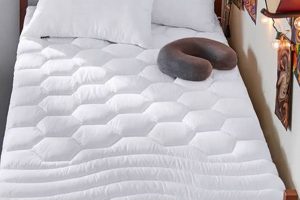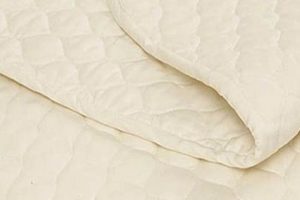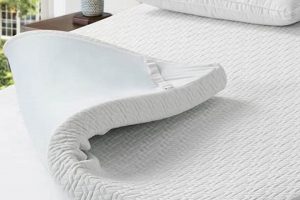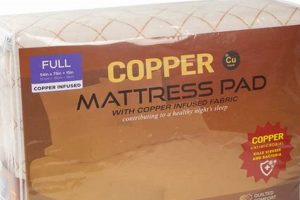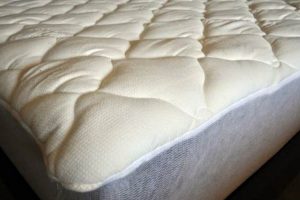The effectiveness of devices designed to regulate temperature on a sleeping surface is a common inquiry. These products, typically placed on top of a mattress, aim to mitigate heat retention and improve sleep comfort through various technologies.
Temperature regulation during sleep is crucial for maintaining a stable core body temperature, facilitating deeper and more restful sleep. Historically, individuals have sought methods to manage sleep surface temperature, ranging from natural materials to advanced cooling technologies. Improved sleep quality can lead to increased daytime alertness, enhanced cognitive function, and overall well-being.
This article will delve into the different types of these temperature-regulating mattress accessories, examine the underlying mechanisms of their functionality, assess their objective performance metrics, and provide guidance on selecting the most suitable option based on individual needs and preferences.
Maximizing the Effectiveness of Mattress Cooling Solutions
Optimizing the performance of temperature-regulating mattress accessories requires careful consideration of several factors to ensure desired results.
Tip 1: Material Compatibility: Select cooling pads constructed from breathable materials such as cotton, bamboo, or specialized synthetic fabrics to enhance airflow and moisture-wicking capabilities. These materials complement the cooling technology and prevent heat buildup.
Tip 2: Technology Evaluation: Understand the specific cooling technology employed by the pad, whether it’s circulating water, phase-change materials, or gel infusions. Research the efficiency and maintenance requirements of each technology to make an informed decision.
Tip 3: Proper Installation: Adhere to the manufacturers instructions for correct installation. Securely attach the cooling pad to the mattress to prevent shifting, which can disrupt airflow and cooling effectiveness.
Tip 4: Ambient Room Temperature Control: Recognize that the effectiveness of cooling pads is influenced by the ambient room temperature. Maintaining a cool and well-ventilated bedroom environment will significantly enhance the performance of the pad.
Tip 5: Regular Maintenance: Follow the recommended cleaning and maintenance procedures to prevent the buildup of dust, allergens, and moisture. Regular maintenance ensures consistent performance and prolongs the lifespan of the cooling pad.
Tip 6: Layering Considerations: Evaluate the impact of bedding layers on cooling pad performance. Avoid using thick, insulating sheets or blankets that can impede airflow and reduce the pad’s effectiveness.
Tip 7: Consider Personal Needs: Individual sleep preferences and body temperature variations should be considered. Those who tend to sleep hot may benefit from more advanced cooling technologies, while those with milder temperature concerns might find simpler options adequate.
By implementing these strategies, individuals can optimize the utility and lifespan of mattress cooling accessories, resulting in improved sleep comfort and overall well-being.
The subsequent section will summarize the key considerations when assessing these products’ overall efficacy.
1. Material Breathability
Material breathability plays a pivotal role in the effectiveness of mattress cooling pads. It dictates the degree to which air can circulate through the pad, influencing heat dissipation and moisture management, critical components for achieving a cooler sleeping environment.
- Air Circulation Enhancement
Breathable materials, such as open-cell foams, cotton, or linen, facilitate continuous airflow around the sleeper. This circulation helps to dissipate body heat, preventing its accumulation within the mattress. Without sufficient airflow, heat becomes trapped, negating the purpose of the cooling pad.
- Moisture-Wicking Capability
Breathable materials exhibit superior moisture-wicking properties, drawing perspiration away from the body. This prevents the buildup of sweat, which can contribute to a clammy and uncomfortable sleeping experience. By promoting evaporation, breathable materials maintain a drier and cooler surface.
- Thermal Regulation Support
The breathability of a cooling pad’s material directly impacts its ability to regulate temperature effectively. Materials with low breathability can insulate the sleeper, hindering the cooling pad’s ability to draw heat away from the body. Highly breathable materials complement the cooling technology, improving overall temperature control.
- Impact on Long-term Performance
The breathability of the material affects the cooling pad’s durability and long-term performance. Breathable materials are less prone to moisture retention, which can lead to the growth of mold or mildew, reducing the lifespan and effectiveness of the cooling pad. Additionally, increased airflow inhibits compression and material degradation over time.
In essence, material breathability forms an integral component of a functional mattress cooling pad. By prioritizing materials that allow for optimal air circulation and moisture wicking, individuals can maximize the heat-dissipating properties and overall effectiveness of the cooling pad, enhancing sleep quality and comfort.
2. Technology Efficiency
The functional efficacy of temperature-regulating mattress accessories is intrinsically linked to the efficiency of the cooling technology employed. The capacity of a device to effectively dissipate heat determines its utility in creating a cooler sleep environment. A high level of technological efficiency directly correlates with the user’s perception of the product’s overall performance.
- Heat Transfer Rate
The rate at which a technology can remove heat from the sleep surface is a primary indicator of its efficiency. Circulating water systems, for instance, possess a quantifiable heat transfer rate, measured in BTU/hour or watts. Systems with higher heat transfer rates are capable of maintaining a cooler surface temperature for a longer duration. Insufficient heat transfer results in a gradual temperature increase, negating the cooling effect. The measureable capacity to remove heat establishes the effectiveness.
- Energy Consumption
The energy required to operate the cooling technology directly influences its practicality and cost-effectiveness. Systems utilizing thermoelectric coolers (TECs) or actively circulating water necessitate electrical power. High energy consumption not only increases operational costs but also affects environmental impact. Efficient technologies minimize energy waste while maintaining optimal cooling performanc
e. Assessment involves evaluating the power input required relative to the obtained cooling output. - Material Properties and Conduction
The inherent thermal conductivity of the materials utilized in cooling pads contributes significantly to their effectiveness. Materials with high thermal conductivity, such as copper-infused foams or specialized gels, facilitate rapid heat transfer away from the body. Conversely, materials with low thermal conductivity can impede heat dissipation. Characterization of material properties is crucial in evaluating a cooling pad’s ability to effectively regulate temperature. Measurement includes conductivity values of specific materials implemented.
- System Longevity and Reliability
The long-term performance and reliability of the technology are critical factors in assessing overall efficiency. Cooling systems with robust components and durable construction are less prone to malfunctions or performance degradation over time. Maintenance requirements and the availability of replacement parts also impact the long-term viability of the technology. Consistent performance over an extended period indicates a technologically efficient and reliable cooling system.
In summary, the degree of technological efficiency inherent within a mattress cooling device directly determines its capacity to regulate sleep surface temperature effectively. Quantifiable metrics such as heat transfer rate, energy consumption, material properties, and system longevity should be carefully assessed to determine the overall utility and value of these products in achieving a cooler and more comfortable sleep environment.
3. Ambient Temperature
Ambient temperature exerts a substantial influence on the functionality of mattress cooling devices. These accessories are designed to facilitate heat dissipation, but their effectiveness is contingent upon the temperature differential between the sleeping surface and the surrounding environment. A higher ambient temperature reduces the device’s capacity to draw heat away from the body, potentially diminishing its intended cooling effect. For instance, a cooling pad might perform adequately in a bedroom maintained at 68F (20C) but exhibit diminished performance in a room with an ambient temperature of 78F (26C). This is because the temperature gradient, which drives heat transfer, is reduced. Understanding ambient temperature is therefore a critical component of determining whether these devices will work as expected.
Furthermore, the type of cooling technology employed interacts with the ambient environment differently. Phase-change materials, for example, rely on absorbing heat to transition from a solid to a liquid state. In warmer environments, these materials may reach their saturation point more quickly, reducing their cooling duration. Actively cooled systems, such as those using circulating water, are also affected, as the cooling unit must work harder to maintain a lower temperature, potentially increasing energy consumption and noise levels. The practical application of this knowledge lies in adjusting expectations based on the typical room temperature and selecting a product accordingly. Individuals in warmer climates may require more robust and actively cooled solutions to achieve comparable results.
In conclusion, ambient temperature is a pivotal consideration in evaluating the overall performance of mattress cooling technologies. It affects the heat transfer rate, the saturation point of cooling materials, and the energy efficiency of active cooling systems. Awareness of this interaction is essential for setting realistic expectations and optimizing the selection and use of such devices to achieve the desired thermal comfort during sleep. Failure to account for ambient temperature can result in dissatisfaction with the product’s performance, even if the device itself is functioning as designed.
4. Individual Needs
The efficacy of temperature-regulating mattress accessories is significantly mediated by individual physiological characteristics and sleep preferences. A universal solution does not exist; therefore, the suitability of a particular product is contingent upon aligning its capabilities with specific user requirements. Factors such as body mass index, metabolic rate, hormonal fluctuations (particularly in women), and pre-existing medical conditions that affect thermoregulation influence the perception of heat and the need for cooling interventions. For example, an individual with hyperhidrosis (excessive sweating) will likely require a more robust cooling solution than someone who typically sleeps at a comfortable temperature. Similarly, individuals experiencing menopausal hot flashes may find significant relief from mattress cooling pads, whereas others might perceive little to no benefit.
Moreover, personal preferences regarding sleeping posture, bedding materials, and ambient room temperature interact with the functionality of these devices. Side sleepers, for instance, may experience more localized heat buildup at pressure points, necessitating targeted cooling in those areas. The type of bedding used (e.g., thick comforters versus lightweight blankets) can either enhance or impede the cooling effect. Furthermore, individual sensitivity to cold also plays a role. Some individuals may find even subtle cooling uncomfortable, while others may require substantial temperature reduction to achieve optimal sleep. Therefore, assessing the individual’s thermal comfort threshold is paramount. Real-world examples include users with circulatory issues that might require them to avoid extreme temperature changes, limiting the usefulness of certain powerful cooling systems. Other users might have specific allergies to certain materials often used in cooling pads, reducing their pool of available options.
In conclusion, the evaluation of whether temperature-regulating mattress accessories offer tangible benefits necessitates a thorough consideration of individual needs and preferences. Physiological factors, sleep habits, and personal sensitivities to temperature fluctuations all contribute to the overall perception of efficacy. Addressing these individual requirements is crucial for maximizing the potential benefits and ensuring satisfaction with these products. Ignoring the individual component can lead to ineffective application and consumer discontent, highlighting the importance of personalized assessment.
5. Maintenance Practices
The operational longevity and continued effectiveness of temperature-regulating mattress accessories are inextricably linked to consistent and appropriate maintenance practices. The extent to which these products successfully achieve their intended functionnamely, the regulation of sleep surface temperatureis directly proportional to the adherence to manufacturer-recommended cleaning and upkeep protocols. Neglecting these procedures can lead to a gradual degradation of performance, premature failure of the device, and potential health concerns related to hygiene. For example, circulating water systems require periodic flushing to prevent the buildup of mineral deposits and microbial growth, which can impede water flow and reduce cooling efficiency. Sim
ilarly, gel-infused pads may accumulate dust, skin cells, and moisture, creating a breeding ground for allergens and diminishing their conductive properties. These consequences directly compromise the accessory’s ability to regulate temperature effectively.
Different types of cooling pads necessitate varying maintenance approaches. Devices incorporating electrical components, such as thermoelectric coolers or active water circulation systems, demand diligent inspection of power cords, connectors, and ventilation ports to ensure safe and efficient operation. Clogged vents, frayed cords, or loose connections can not only impair performance but also pose electrical hazards. Non-electric pads, such as those relying on phase-change materials, also require attention. These materials may degrade over time with repeated use and improper care, leading to reduced thermal capacity. Regular cleaning, as specified by the manufacturer, is essential to remove surface contaminants and maintain optimal performance. The practical significance lies in the tangible return on investment: consistent maintenance extends the lifespan of the product, preserves its functionality, and protects the user from potential health risks associated with neglect.
In summary, maintenance practices are not merely ancillary considerations but integral components of temperature-regulating mattress accessories’ overall performance. The cause-and-effect relationship is clear: diligent maintenance results in sustained cooling efficiency, extended product lifespan, and a healthier sleep environment. Conversely, neglect leads to diminished performance, potential health hazards, and premature replacement. The practical significance lies in recognizing maintenance as a necessary investment, ensuring that these products continue to deliver their intended benefits and justifying their initial cost.
6. Proper Installation
The successful operation of mattress temperature regulation devices is fundamentally dependent upon adherence to correct installation procedures. A failure to properly install these accessories directly diminishes their intended effect, irrespective of the inherent capabilities of the technology employed. The correct placement, securing, and connection of components are not merely procedural steps but prerequisites for optimal performance. For example, a circulating water system with a kinked hose due to improper installation will experience reduced water flow, directly impacting its ability to dissipate heat effectively. Similarly, a cooling pad not securely attached to the mattress surface will shift during sleep, creating inconsistent temperature regulation and negating the intended cooling effect. This direct cause-and-effect relationship underscores the importance of proper installation as an indispensable component of these products’ effectiveness.
Furthermore, specific installation requirements vary significantly depending on the type of technology used. Systems requiring electrical connections necessitate verification of proper voltage and secure plug insertion to prevent malfunctions or safety hazards. Water-based systems demand careful attention to hose connections and reservoir filling procedures to avoid leaks and ensure adequate fluid circulation. Even seemingly simpler gel-infused pads require proper placement to maximize contact with the body and facilitate effective heat transfer. Ignoring these specific installation instructions can not only compromise performance but also void warranties and potentially damage the mattress. The practical application of this understanding lies in the careful review and meticulous execution of the manufacturer’s instructions, ensuring that each component is correctly positioned and secured to facilitate optimal operation.
In conclusion, proper installation is not a trivial step but a critical determinant of whether mattress cooling devices achieve their intended purpose. It directly influences the efficiency of heat transfer, the consistent regulation of temperature, and the overall safety of the system. Challenges arise when users neglect to read or understand the installation manual, leading to compromised performance and dissatisfaction. Therefore, recognizing installation as a foundational element and diligently adhering to the prescribed procedures are essential for realizing the potential benefits of these temperature-regulating sleep accessories. This understanding links directly to the broader theme of evaluating the effectiveness of such devices, highlighting that proper usage is as important as the technology itself.
Frequently Asked Questions
This section addresses common inquiries regarding the performance and suitability of mattress cooling pads.
Question 1: What is the expected lifespan of a mattress cooling pad?
The lifespan varies depending on the type of cooling technology, the quality of materials, and the intensity of use. Circulating water systems may last for several years with proper maintenance, while gel-infused pads may exhibit a shorter lifespan due to gradual material degradation. Refer to the manufacturer’s specifications for estimated durability.
Question 2: Can mattress cooling pads be used with memory foam mattresses?
Yes, mattress cooling pads are generally compatible with memory foam mattresses. However, the dense nature of memory foam can impede airflow, potentially reducing the cooling pad’s effectiveness. Select cooling pads with high breathability and effective heat transfer capabilities to mitigate this issue.
Question 3: Are mattress cooling pads noisy during operation?
Noise levels depend on the cooling technology employed. Circulating water systems and thermoelectric coolers may produce a low humming or whirring sound. Gel-infused and phase-change material pads are typically silent. Consider noise sensitivity when selecting a cooling pad.
Question 4: Are mattress cooling pads energy-efficient?
Energy efficiency varies among different types of cooling pads. Circulating water systems and thermoelectric coolers require electricity, and their energy consumption can range from moderate to high. Gel-infused and phase-change material pads do not require electricity and are therefore considered energy-efficient.
Question 5: Can mattress cooling pads be cleaned?
Cleaning procedures depend on the type of cooling pad. Removable covers can typically be machine-washed. However, components containing electrical or mechanical parts may require spot cleaning or professional servicing. Refer to the manufacturer’s cleaning instructions.
Question 6: Are there any potential health concerns associated with using mattress cooling pads?
Potential health concerns are minimal but may include allergic reactions to specific materials or discomfort from excessive cooling. Individuals with circulatory issues or heightened sensitivity to cold should exercise caution and consult with a healthcare professional before using mattress cooling pads.
In summary, the effectiveness of mattress cooling pads is influenced by numerous factors, including the type of technology, individual needs, and proper maintenance. A balanced assessment of these considerations is essential for making an informed purchasing decision.
The next section will provide final thoughts and guidance.
Conclusion
The preceding analysis demonstrates that the functionality of mattress cooling pads is not a binary proposition. The claim that “do mattress cooling pads work” is nuanced and contingent upon several variables, including material
composition, technological efficiency, ambient temperature, individual physiological needs, and consistent adherence to maintenance and installation protocols. A blanket assertion of efficacy is therefore misleading without acknowledging these moderating factors.
Ultimately, the decision to utilize a mattress cooling pad should be predicated upon a comprehensive evaluation of individual requirements and realistic expectations regarding the product’s potential benefits. Further independent research and comparison of available options are encouraged to ensure informed consumer choice and maximize the likelihood of achieving the desired sleep environment. The pursuit of thermal comfort remains a subjective endeavor, demanding diligent consideration of both the product’s capabilities and the user’s specific circumstances.



